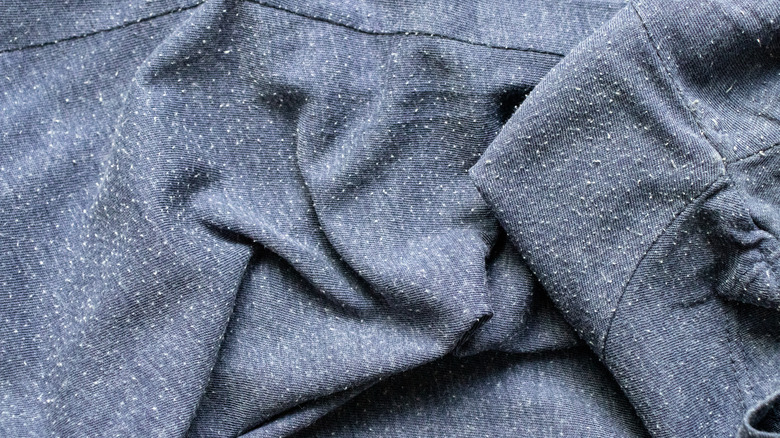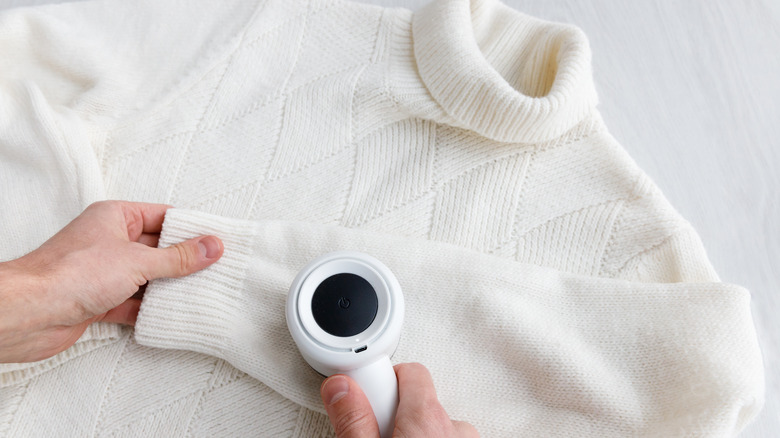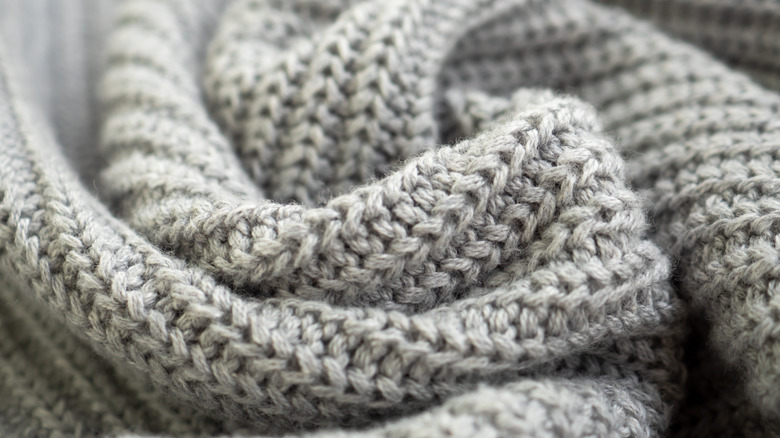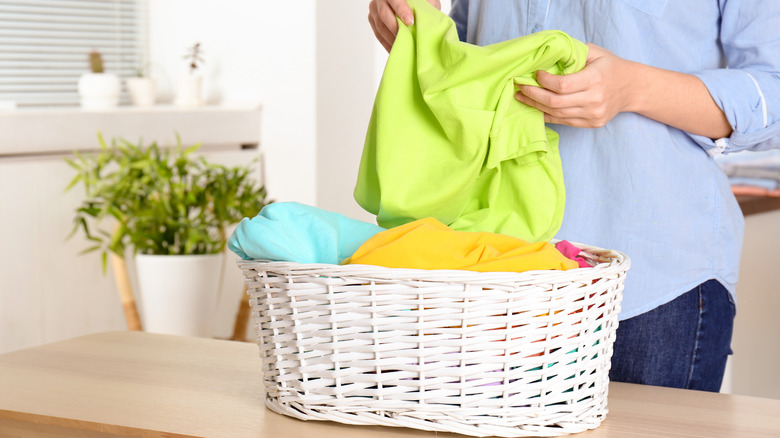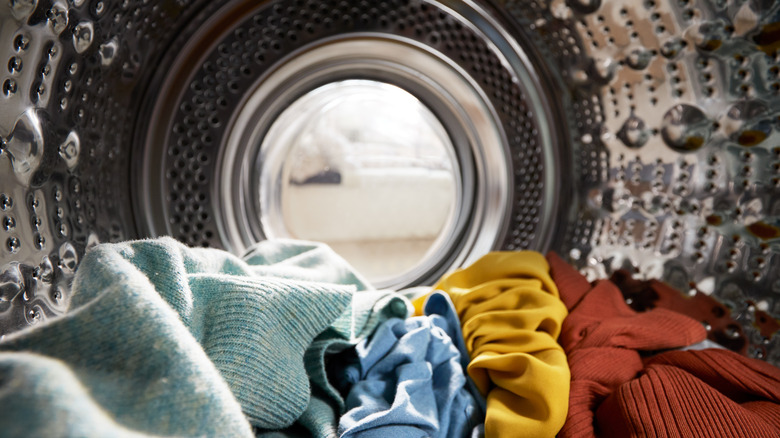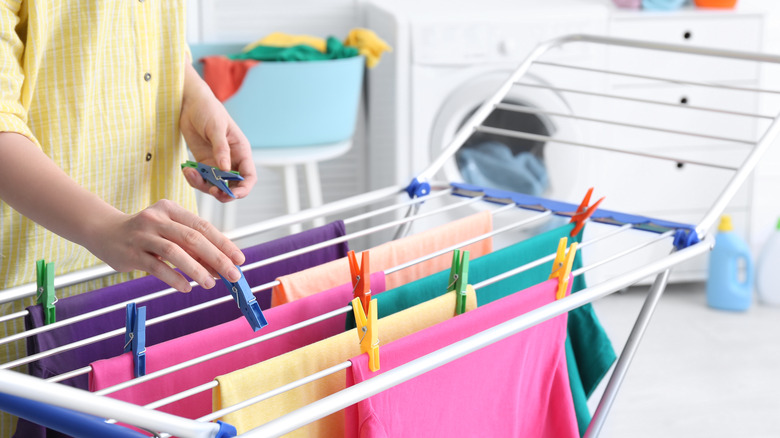The Best Way To Get Rid Of Pilling On Clothes
We may receive a commission on purchases made from links.
It can be daunting when your favorite blanket, coziest sweater, or best-fitting pair of jeans begin to form unsightly little firm balls. These little pills, as they are affectionately known, are caused when the fabrics rub against each other. Pilling often develops in the armpit and inner thigh areas but can happen anywhere friction happens. While there aren't any negative effects to pilling, it can make an outfit look unprofessional.
While it can take hours to remove each pill, there are simple ways to prevent and remove pilling from clothing. Knowing how to do your laundry correctly, including sorting your clothes, using the gentle cycle, and hang drying, can help your wardrobe stay the way you first bought them. You can use these methods when you see new pilling start to form or if you're in the mood to go through your whole closet and remove all the pills you find.
Use a fabric comb
Using a handheld fabric comb can be one of the easiest and safest ways to remove pilling. You can buy them from Amazon for less than $20, with options ranging from electric or non-electric. If you have never used a fabric comb, it's pretty simple.
- Lay a clothing item on a flat surface.
- Pull the fabric tight to keep it in place.
- Shave the pilling while pulling away from the fabric.
- Repeat until all pilling is gone.
If you don't have a fabric comb, you can use scissors and cut the pilling individually, or you can use a razor and shave off the pilling. Be extremely careful if using the razor so that you don't accidentally harm yourself. If you don't prefer to use a sharp item, you can use a pumice stone. Using the stone can be rougher on the garment and should be used with care, but it'll provide the same results as the other methods.
Invest in tightly woven fabric
Good Housekeeping suggested purchasing clothing that has tightly woven fabrics. When the fibers on a piece of clothing are loose, it's easy for it to begin to pill. Tighter fabrics have stronger fibers which will prevent pilling from happening. There are different materials that are considered tightly woven, such as twill weave, satin weave, and plain weave per Candor threads. Fabrics made of silk and linen pill less than wool, cotton, polyester, and other synthetic threads. If there's a blend of materials, the weaker fabric will always pill.
The clothing tags on the inside will give you a breakdown by percentage of what type of materials are in the clothing you're buying; that way, you can determine whether to buy it or find something that will be more long-lasting. The more you familiarize yourself with the various types of fabrics, the easier it'll be to remember which are less likely to have pilling from regular use.
Prepare clothing before washing
This may seem like an obvious thing to do since you don't want to end up with a white shirt turning pink from a red sock, but sorting your clothes can also help prevent the colored fabric from forming pills on lighter-colored clothing, according to Gentleman's Gazette. Even though you could still end up with some pilling after a wash load, it'll at least be the same color as the clothing item. This also helps prevent harsh abrading and damage to light-colored clothing.
When you're getting ready to wash your clothes in the washing machine, turning them inside out can lessen the amount of abrasion to the surface of the clothes, per The Spruce. If you wash them as is, then the zippers or buttons can cause pilling and further damage to your clothes. If you decide to hand wash, you don't need to worry about turning them inside out.
Use the gentle cycle
Most clothing items have a tag on the inside that tells you how you should wash that article of clothing. Following the label tag will help prevent any pills from forming when you wash your clothes, according to Rei Co-op. If you usually cut off the wash tag then use a gentle cycle. When you wash clothes on a gentle cycle, it keeps the fabrics from rubbing harshly against one another.
Hand washing your clothes can also prevent pilling from forming since you are washing one item at a time. If you're used to using the washing machine, check the detergent you're using and make sure it's a gentle one. Many detergent brands have options that are gentle and contain no dyes or scents. Liquid detergents made without any harsh chemicals or bleaches are best for your clothes. It's wise to stay away from powder detergents because they could cause more abrasion.
Hang dry clothing
When you've finished washing your clothes, hanging them to dry can also prevent pilling from forming, per Good Housekeeping. You can lay them out on a clothing rack in your home or clothing line outside. They stay separate from other items instead of rubbing against each other in the heat of the dryer. Even though leaving your clothes to hang will take longer for them to dry, they'll last longer and be pill-free. Air drying your clothing also lessens the amount of time you may spend ironing stuff because they'll lay flat for an extended period of time instead of tumbling around getting tangled with other clothes.
Amazon has clothes drying racks for under $25, as well as more expensive ones, depending on your budget. They're easy to store away underneath your bed or in a closet so that it's not in the way. You can also hang dry clothes with basic hangers — using your shower curtain rod as a clothesline replacement when there's inclement weather outside.
